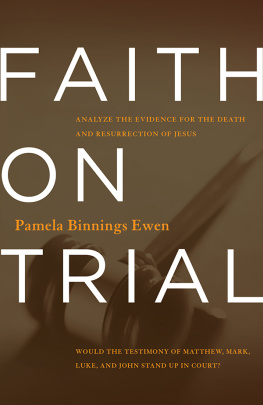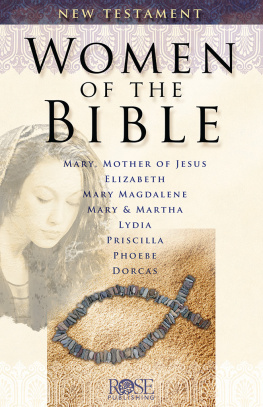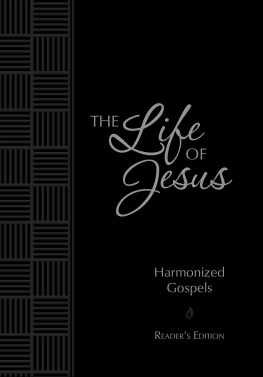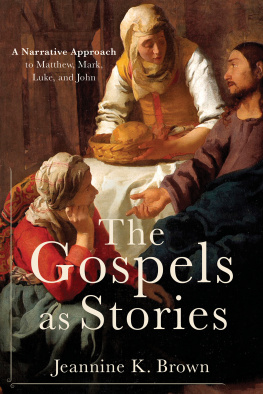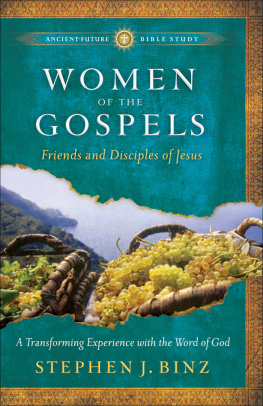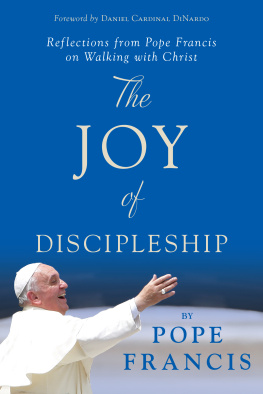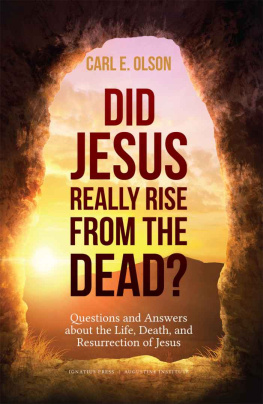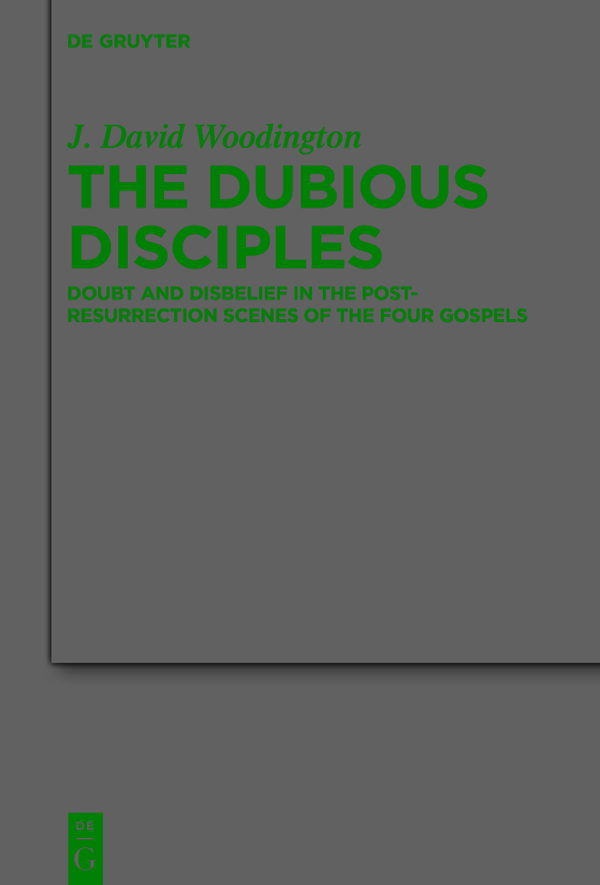Beihefte zur Zeitschrift fr die neutestamentliche Wissenschaft
Edited by
Matthias Konradt
Erich Grer
Richard B. Hays
Judith Lieu
Laura Nasrallah
Jens Schrter
Gregory Sterling
Carl Holladay
Hermann Lichtenberger
James D. G. Dunn
Michael Wolter
Volume
ISBN 9783110691559
e-ISBN (PDF) 9783110691788
e-ISBN (EPUB) 9783110691825
Bibliographic information published by the Deutsche Nationalbibliothek
The Deutsche Nationalbibliothek lists this publication in the Deutsche Nationalbibliografie; detailed bibliographic data are available on the Internet at http://dnb.dnb.de.
2020 Walter de Gruyter GmbH, Berlin/Boston
Introduction
This project is motivated by a simple question: Why do the Gospels of Matthew, Luke, and John, as well as the Longer Ending of the Gospel of Mark, include moments of doubt in the disciples after the resurrection of Jesus? At first glance, this would seem an unlikely element to appear in these accounts. It is one thing for the disciples to struggle with doubts as they learn what it means to be a true follower of Jesus; it is quite another for these key figures to falter so dramatically at the moment of their Lords triumphant return. Within the New Testament itself, it is clear that some Christians had a negative view of doubt. The Epistle of James, for instance, does not mince its words when labeling the doubter like a wave of the sea, being driven and tossed by the wind (Jas 1:6) and double-minded, unstable in all his ways (Jas 1:8).
Even more, the disciples mistakes are not only present but highlighted in the post-resurrection scenes. In their canonical forms, the Gospels place an apparent emphasis on this reaction by the disciples and elaborate upon the matter in detail. Despite Jesuss statements concerning his return after death (e.g., Mark 8:31; Matt 17:22; Luke 9:22; John 2:1921), they distrust fellow followers who report his resurrection (Mark 16:1113; Luke 24:11; John 20:25), cannot believe the sight of the risen Lord before them (Matt 28:17; Luke 24:37, 41), and are directly confronted by Jesus about their failure to believe, occasionally in quite harsh terms (Mark 16:14; Luke 24:2526, 3839; John 20:2729). One might expect this to be just a momentary stumble, but often the disciples doubt is never clearly resolved. Only John 20:2829 depicts a definite overcoming of this problem by Thomas. One can assume that the same is implied by the disciples worshiping (Matt 28:17; Luke 24:5253) or spreading the good news (Mark 16:20), but this is never made explicit in the other three Gospels. Especially conspicuous in this regard is Matthew, where doubting is the last act of the disciples in the entire book (Matt 28:17).
Beyond the mere presence of such scenes, the diversity among the four accounts is striking. Although they share some similarities with one another, each Gospel has an entirely unique post-resurrection narrative with various elements not found in any of the other three. Not surprisingly, this is particularly true of John and his story of Thomas, but the Synoptic Gospels all differ from one another in noteworthy ways as well. For instance, only the Longer Ending of Mark has the disciples reject two separate instances of testimony to Jesuss resurrection (Mark 16:14), and only Luke mentions the issue of Jesus being perceived as a ghost (Luke 24:37, 39). When explaining the presence of these accounts, this diversity must be taken into consideration.
Variations appear even at the most basic level of vocabulary as a range of words are used in the Gospels to depict the responses of the disciples. The most common choices are and its related roots and , which appear multiple times in both Mark (Mark 16:11, 14 16) and Luke (Luke 24:11, 41) and once in John (John 20:27). As their etymology suggests, these terms imply a lack of belief, but their precise meaning depends upon context, including possibilities such as a temporary sense of shock in reaction to something utterly unexpected (disbelief, incredulity, astonishment), a lingering sense of unsureness or inability to fully believe something (doubt, skepticism, distrust, dubiousness), or a complete lack of belief altogether (unbelief, faithlessness). The importance of context in deciding the correct meaning in each instance cannot be overstated. Marks Jesus harshly rebuking the disciples for their while equating it to hard-heartedness (Mark 16:14) and saying that those who do this will be condemned (Mark 16:16) is clearly something very different from Lukes report that the disciples felt this way on account of joy (Luke 24:41).
In addition to the immediate surroundings of the individual verses, how these terms have been used previously in each Gospel will necessarily impact their interpretation in these final episodes. Beyond the cluster of - vocabulary, the evangelists utilize two other words in reference to the disciples post-resurrection disposition: (Matt 28:17) and (Luke 24:38). Both can mean doubt in the sense listed above, but they can also refer to a momentary sense of mental debate as one chooses between multiple options (uncertainty, hesitation, deliberation) or, in the case of , simply thoughts in general. One must play close attention to these distinctions and be careful in how the disciples reactions are described in each case.
1.1 A Brief History of Scholarship
There is a prodigious amount of scholarship devoted to the topic of the resurrection, but relatively little attention has been paid to the doubt of the disciples specifically. In works on the resurrection, their skepticism is typically mentioned only briefly and with little consideration for the rhetorical role it might play in each Gospel. Understandably, authors have generally chosen to focus on other issues such as the historicity (or lack thereof) of the resurrection, phenomenological precedents for bodily resurrection in Greco-Roman and Jewish sources, and the monumental effect of the resurrection on Christian life, both ancient and modern. These topics are well deserving of discussion, but a suitable analysis of doubt in the post-resurrection pericopae has often been left aside amidst everything else.
The question of why such scenes might have been included in the first place has rarely been addressed in these works. When it has been, scholars have provided two major answers. The first is a straightforward one: The disciples really did doubt when Jesus was resurrected, so the Gospels testify to the historical fact of their doubt. The disciples are only human, and it would be natural to respond to the shocking nature of the resurrection in this kind of way. Representative in this regard are the comments of Grant Osborne, who remarks that it should not be difficult [] to understand how men of that era would experience doubt and fear in the midst of such an event.
More often, however, a second answer is provided. Instead of verifying the historical nature of the disciples and their skepticism, commentators assert that this element was a traditional part of the resurrection account. Early Christians were familiar with doubting disciples as part of the report of Jesuss resurrection and would have expected this to be present in any depiction of the Lord's return. Because of this, the evangelists were forced to include this detail, regardless of their feelings on the matter. Buttressed by form-critical arguments, this tradition-historical claim has more support than its purely historical counterpart. But while it puts the question of historicity aside as a separate or even unknowable issue, the effect is largely the same: The ancient writers depicted doubting disciples because they and their readers accepted them as an inherent part of the resurrection account.


